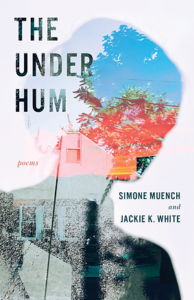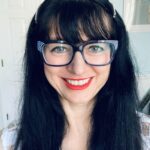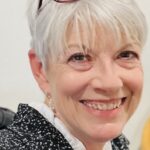Today I have two special guests, poets Simone Muench & Jackie K. White to chat with me about their new book, The Under Hum.

Bios:
Jackie K. White earned her PhD in Creative Writing (poetry) from UIC with concentrations in Latinx/Latin American and Women’s Studies and was a Professor of English, now Professor Emerita, at Lewis University for fifteen years. She has served as an editor for the literary journals RHINO and Jet Fuel Review, and is the co-translator, with Frances Aparicio, of César Rondón’s The Book of Salsa (UNC Press, 2008) as well as an assistant editor of They Said: A Multi-Genre Anthology of Contemporary Collaborative Writing (Black Lawrence Press, 2018). She is the author of three chapbooks: Bestiary Charming, 2006 Anabiosis Press Award; Petal Tearing & Variations, Finishing Line (2008); and Come Clearing, Dancing Girl Press, 2012. Her poems and translations have appeared in ACM, Bayou, Fifth Wednesday, Folio, Quarter after Eight, Spoon River, Third Coast, and Tupelo Quarterly, among others. A collaborative chapbook of poems written with Simone Muench, Hex & Howl, was published in 2021(Black Lawrence) and their full-length collection, The Under Hum, was released in June, 2024, also with Black Lawrence Press.
Simone Muench is the recipient of an NEA Poetry Fellowship; the 2023 Lewis University Career Scholarship Award; a 2023 Illinois Arts Council Fellowship, and the Meier Foundation for the Arts Award. She is the author of seven full-length books including The Under Hum, cowritten with Jackie K. White, (Black Lawrence Press, June 2024). She is the creator of the Hungry Brain Sunday Reading Series that she co-hosts with Kenyatta Rogers. She serves as poetry editor for JackLeg Press, a poetry editor for Tupelo Quarterly, and faculty advisor for Jet Fuel Review. She received her PhD from the University of Illinois at Chicago and directs the writing program at Lewis University where she teaches creative writing and film studies.
What do you enjoy most about writing poems?
Jackie and Simone: Playing with language and the discoveries that come with that, whether through sounds calling to sounds, through the turn of the line and the evolution of a form initially unintended, or through the sudden appearance of an image unexpected; in other words, the joy of letting the poem take the lead.
Can you give us a little insight into a few of your poems – perhaps a couple of your favorites?
Jackie: My favorite of our poems is “Against Teleology,” as the title and opening line just “came to me” and as I like the whole poem’s approach to the ever-problematic Eve myth. I’m also proud of our “Portrait as Landscape: Dear, dark garden,” first, for Simone’s rich idea of making “landscape” an object for portraiture, and, secondly, for how we address the too many unknown and hidden abductions and abuses of girls in seemingly safe neighborhoods. Another of my favorites is “Abecedarian for the Walking Woman” in which we enjamb the acrostic structure and use a staccato syntax. I’d like to offer our readers an insight into the book as a whole, noting how the overall structure moves from and weaves in images foregrounding violence against women to “protest” poems that assert agency and survival. As Amy Penne points out in her The Compulsive Reader review, “There are brutal truths outlined here, but there is a persistence, a clawing, a demand to be seen.” Related to our feminist themes and to poetry as collaboration, we bring in a number of other poets to showcase how “Language is a key concept here, the hum [referenced in our title] amplified by this multitude of voices,” as Charles Rammelkamp notes in his London Grip review.

Simone: I like our “Self Portrait Lined by. . . “ poems as I’ve always viewed writing as a call-n-response activity in which I’m inspired by others to become part of the conversation. I have a predilection for citational work as I think it’s important to foreground the lineage that one is working within, paying homage to predecessors and influences. I also enjoy writing recursive poems like “Portrait as Landscape: Untranslatable” in which we choose a handful of diction to puzzle through and tease out in various connotative strands.
What form are you inspired to write in the most? Why?
Jackie and Simone: Variations of the sonnet have emerged quite often, given that its dialogic nature—its rhetorical problem/solution, question/answer, call and response structure—lends itself to collaborative writing. We rarely, however, choose a form, but, rather, let the poem, as it develops, choose for itself. In revision, we are open to finding that a poem we began in couplets, tercets, quatrains, or open-field, sings more effectively in a different stanzaic form, and, to that end, our sonnets often shake up the traditional sonnet.
What type of project are you working on next?
Jackie and Simone: Given the pleasures we’ve enjoyed writing collaboratively, we’re continuing in that vein, exploring now, the somewhat forgotten or less celebrated works of women involved in the Surrealist movement. This project is leading us to the development of a number of new forms, such as the “Doppelganger Portrait,” a new approach to the cento using the collage techniques so popular with surrealists, and more explicit dialogues, such as “Dora and Dorothea Talk Through Doors,” and to exploring the epistolary and prose poem, as in our poems, “Dear Z—” “Xenia Sends a Rebuttal,” and “Kay Sage’s Postcard from the Coast.”
When did you first consider yourself a writer / poet?
Jackie: In college, during my first creative writing course that led to my first publication, but I had been playing with poem-writing since the 3rd grade.
Simone: Like Jackie, probably not until college, though in high school I was a Sylvia Plath devotee and was writing overly-alliterative, angsty poetry trying to emulate her brilliance. I recently found a handwritten note from one of my teachers when I was seven, who wrote, “She takes pride in her writing and makes her letters correctly. She also does well in spelling and creative writing.” So, even, at that age, poetry was on the writing horizon.
How do you research markets for your work, perhaps as some advice for not-yet-published poets?
Jackie: I like to explore the journals in which the poets I’m reading have been published. I also enjoy browsing the journals that libraries and bookstores have on their shelves.
Simone: As Jackie mentioned, I like to submit my pieces to places who are publishing work that I love. If I have a kinship with the pieces appearing in a particular lit journal then I know I’d be honored to have work published there.
What would you say is your interesting writing quirk?
Jackie and Simone: we employ a number of “doublings,” such as “between autograph and erasure,” “between sunlight and tarpit” in “Self Portrait Lined by Christina Rossetti,” which is probably a feature of collaborative writing! And, given our subject matter of society’s silencing of women, we also tend to use “un” words—“untethered,” “unfolding,” and participles—“spooling,” “spinning,” “gnawing,” “singing”—to demonstrate the processes that women engage in to move beyond the stasis often imposed on them. Imagistically, we rely on animals a lot, perhaps to demonstrate the power of our speakers.
As a child, what did you want to be when you grew up?
Jackie: First, I wanted to be a ballerina, but my height didn’t work out for that! Then, a teacher because I’ve always loved school. Once I learned how to fish, I imagined becoming a marine biologist, but the other “weird” creatures of the sea made me give up that idea, so I stuck with teaching, and writing poems followed.

Simone: Fashion designer, romance novelist, interior decorator, hip hop dancer. . . unfortunately, I do not have the skill set for any of these.
Anything additional you want to share with the readers?
Jackie and Simone: We’d like to encourage other poets to try their hands at collaborative writing for the challenges and joys and skill-enlarging it offers. It also opens one up to new approaches that keep one’s writing fresh and to experiences that emphasize the communal, versus solitary, nature of poem-making.
Links:
Website | Instagram | Facebook | Black Lawrence Press
